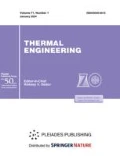Abstract
An automatic control system to control the thermal load (ACS) in a drum-type boiler under random fluctuations in the blast-furnace and coke-oven gas consumption rates and to control action on the natural gas consumption is considered. The system provides for use of a compensator by the basic disturbance, the blast-furnace gas consumption rate. To enhance the performance of the system, it is proposed to use more accurate mathematical second-order delay models of the channels of the object under control in combination with calculation by frequency methods of the controller parameters as well as determination of the structure and parameters of the compensator considering the statistical characteristics of the disturbances and using simulation. The statistical characteristics of the random blast-furnace gas consumption signal based on experimental data are provided. The random signal is presented in the form of the low-frequency (LF) and high-frequency (HF) components. The models of the correlation functions and spectral densities are developed. The article presents the results of calculating the optimal settings of the control loop with the controlled variable in the form of the “heat” signal with the restricted frequency variation index using three variants of the control performance criteria, viz., the linear and quadratic integral indices under step disturbance and the control error variance under random disturbance by the blastfurnace gas consumption rate. It is recommended to select a compensator designed in the form of series connection of two parts, one of which corresponds to the operator inverse to the transfer function of the PI controller, i.e., in the form of a really differentiating element. This facilitates the realization of the second part of the compensator by the invariance condition similar to transmitting the compensating signal to the object input. The results of simulation under random disturbance by the blast-furnace gas consumption are reported. Recommendations are made on the structure and parameters of the shaping filters for modeling the LF and HF components of the random signal. The results of the research may find applications in the systems to control the thermal processes with compensation of basic disturbances, in particular, in boilers for combustion of accompanying gases.
Similar content being viewed by others
References
S. V. Altyn and S. I. Vinogradov, “Increasing precision of fuel flow control of gas-masut boilers,” Energetik, No. 7, 4–5 (1984).
S. K. Ismatkhodzhaev and M. Takhirdzhanov, “Automatic control of thermal load of the boiler unit during combined combustion of blast-furnace, coking and natural gases,” Prom. Energ., No. 9, 40–42 (1979).
G. M. Rublev and G. D. Garnits, “Automatic control of thermal load of a boiler that burns several types of fuel simultaneously,” Prom. Energ., No. 6, 30–31 (1975).
S. K. Ismatkhodzhaev, “Automatic control system for boiler load during combined and separate combustion of gases,” Teploenergetika, No. 10, 55–61 (2014). doi 10.1134/S0040363614100063
V. F. Kuzishchin and S. V. Petrov, “A procedure for tuning automatic controllers with determining a second-order plant model with time delay from two points of a complex frequency response,” Therm. Eng. 59, 779–786 (2012).
R. B. Blackman and J. W. Tukey, “The measurement of power spectra from the point of view of communications engineering—Part I,” Bell Syst. Tech. J. 37, 185–282 (1958); R. B. Blackman and J. W. Tukey, “The measurement of power spectra from the point of view of communications engineering—Part II,” Bell Syst. Tech. J. 37, 485–569 (1958).
S. K. Ismatkhodzhaev, Methods of the Theory of Random Functions in Overwater Gravimetric Observations (Nauka, Moscow, 1970) [in Russian].
V. V. Volgin and R. N. Karimov, Evaluation of Correlation Functions in Industrial Control Systems (Energiya, Moscow, 1979) [in Russian].
G. A. Pikina, T. E. Shchederkina, and V. V. Volgin, Identification of Controlled Plants in Thermal Power Engineering: A Handbook for Higher Schools, Ed. by V. V. Volgin (Mosk. Energ. Inst., Moscow, 2011) [in Russian].
V. Ya. Rotach, Theory of Automatic Control (Mosk. Energ. Inst., Moscow, 2008) [in Russian].
Author information
Authors and Affiliations
Corresponding author
Additional information
Original Russian Text © S.K. Ismatkhodzhaev, V.F. Kuzishchin, 2017, published in Teploenergetika.
Rights and permissions
About this article
Cite this article
Ismatkhodzhaev, S.K., Kuzishchin, V.F. Enhancement of the efficiency of the automatic control system to control the thermal load of steam boilers fired with fuels of several types. Therm. Eng. 64, 387–398 (2017). https://doi.org/10.1134/S0040601517050032
Received:
Accepted:
Published:
Issue Date:
DOI: https://doi.org/10.1134/S0040601517050032



